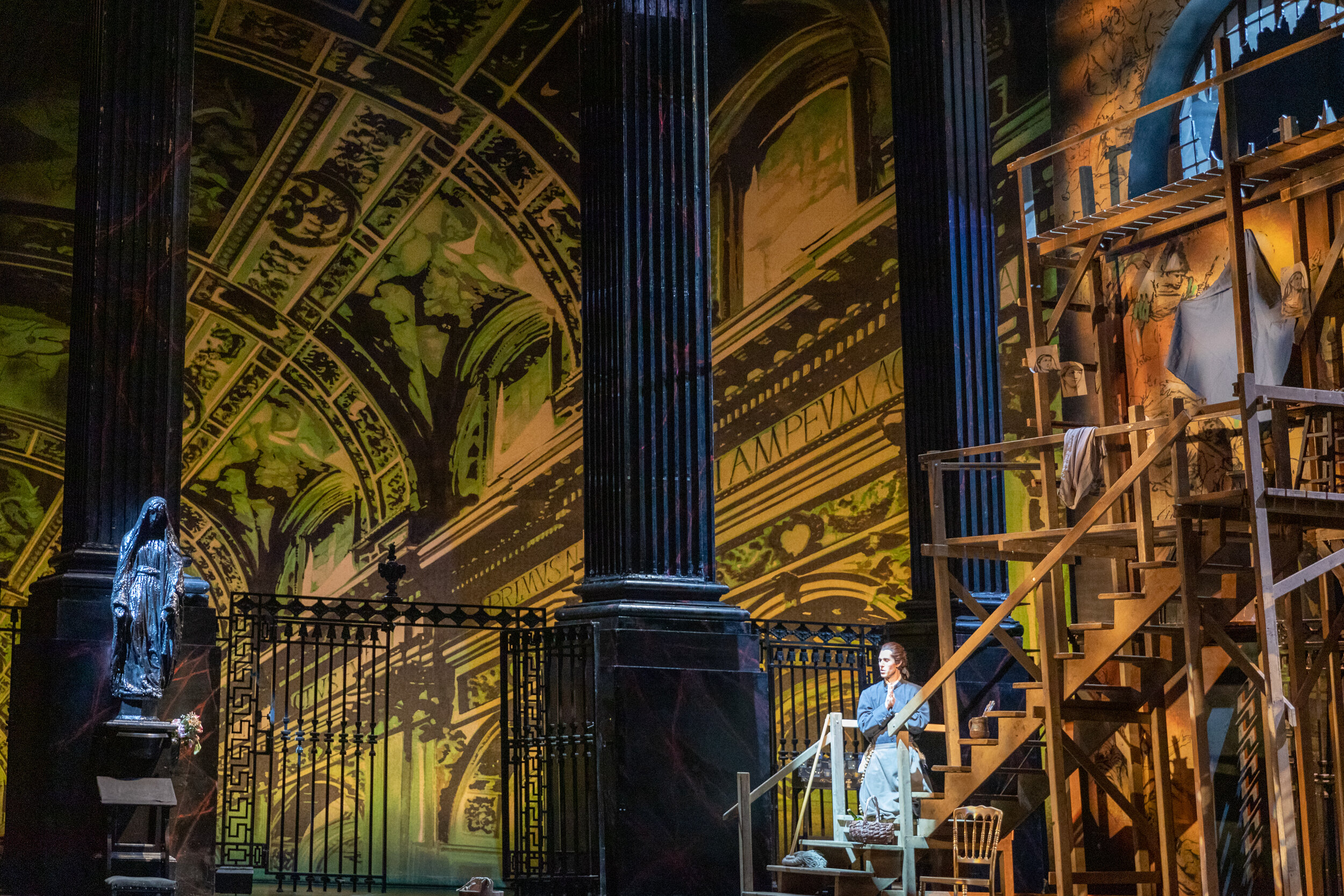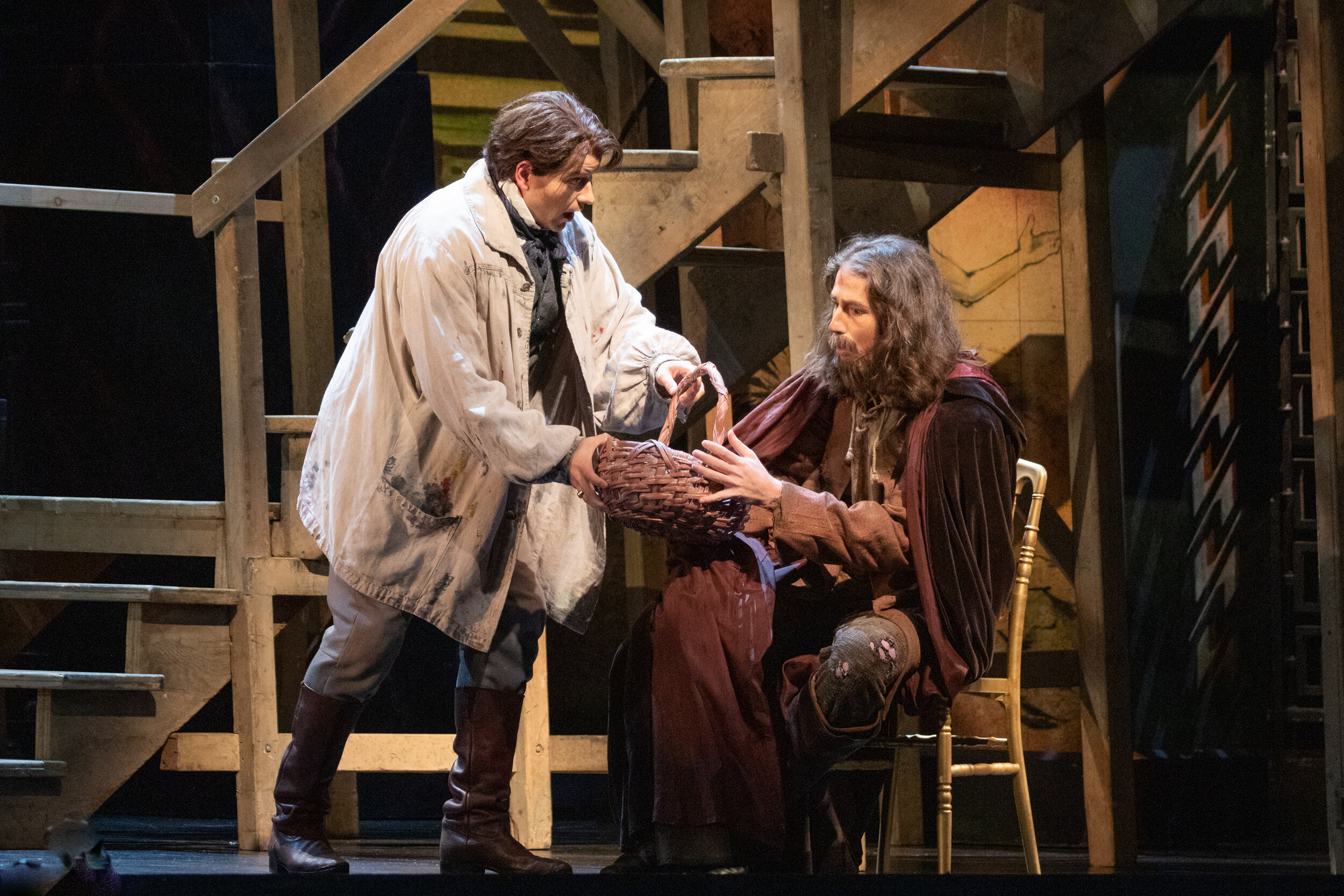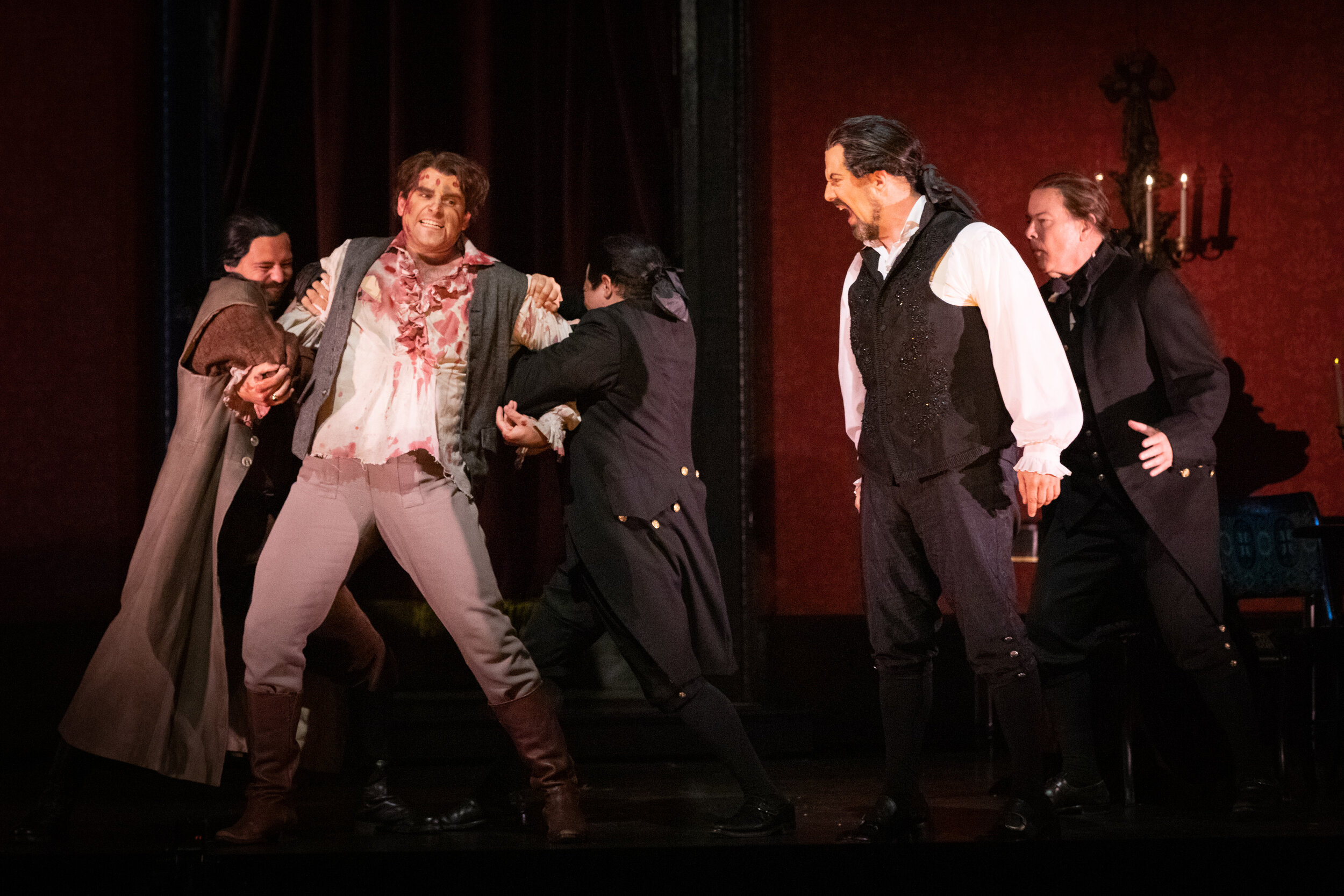I attended Virginia Opera’s Tosca Saturday night and as I think about it today, I so wish I had gotten a ticket for Sunday’s matinee as well. So many questions. Oh, it’s a good show with fabulous music and singing. Giacomo Puccini’s “shabby little thriller”, as one early critic called it, has never failed to deliver in my experience, and I don’t mean to ignore his outstanding librettists, Luigi Illica and Giuseppe Giacosa. There are many fine features to VO’s production with only a few minor complaints from me. One of the three main characters in Tosca is a painter, so let’s examine VO’s Tosca as if it were a painting or a series of paintings like Thomas Cole’s “The Voyage of Life” (National Gallery of Art in DC) covering the four stages of a man’s life; we will only cover 16 hours. Our paintings’ canvases and backgrounds are provided by Director Lillian Groag and the creative staff. The singers playing their roles claim our eyes and ears, revealing themselves visually, further defined by vocal and musical colorations. Their actions keep the colors changing before our eyes, leading to a series of paintings that move by us so fast that we can’t look away, nor even stop to examine one in more detail; like a river current, Tosca sweeps us up and carries us along at a breath-taking pace. Tosca doesn’t have a paint by the numbers set, so let’s paint by the singers. See how your paintings differ from mine. (Caution- plot spoilers abound after this point)
Matthew Vickers as Mario Cavaradossi and Ewa Płonka as Floria Tosca. Photo by Ben Schill Photography; courtesy of Virginia Opera.
First a word about the canvas, the macroenvironment shaping Mr. Puccini’s opera: it is 1800 and Napoleon is marching on Rome to crush the rule of the church and the monarchy in power, a rule much favored by most Romans. Italy is not a unified country then, but a collection of fiefdoms. Some Romans secretly support Napoleon’s establishment of an Italian republic and its freedoms. There is tension in the air as the status quo of all Romans is at stake. At first there is word Napoleon has lost a key battle, but then later as the opera progresses, news comes that Napoleon has won. (See this blog report for an excellent historical summary of the real events that influenced Tosca’s storyline).
left: Joshua Arky as Sacristan. right: Matthew Vickers as Cavaradossi and Andrew Simpson as Cesare Angelotti. Photos by Ben Schill Photography; courtesy of Virginia Opera.
Mario Cavaradossi – We will use lots of red for this virile, even hot-blooded young man, patriotic in his own way. Life is good believes painter Mario Cavaradossi. He is painting a new portrait of Mary Magdalene for a private chapel inside the church of Sant’Andrea delle Valle, a landmark cathedral in Rome. He is an artist, a handsome young man, wealthy and in love, of noble virtue. He appreciates his model’s beauty, her blue eyes, though not as lovely as his Tosca’s brown eyes. He believes in freedom from the church and monarchy, though he has apparently not yet rebelled. Nothing bad ever happened to him before. That’s one side of Mr. Cavaradossi. He is also sees himself as an elite, of better station than the Sacristan working in the church and the Roman chief of police who will be his undoing. He assumes he is protected by his station in life. Then, an escaped political prisoner and former friend, Angelotti, appears needing his help; we will color him gray as he stays in the shadows. In the next 16 hours, Mr. Cavaradossi will be tortured, betrayed by his love, and dead. I am unsure if he sees his cause or just himself as heroic, but he remained true and unyielding to the end. Cavaradossi is played by tenor Matthew Vickers, who has been a VO young artist and who sang the role of Pinkerton in VO’s recent Madama Butterfly. I am happy to report that this is the best that I have heard Mr. Vickers. He is an excellent Cavaradossi visually and vocally, especially in Acts I and III, spirited in Act I and displaying heart touching beauty in Act III. He has a rich, lovely tenor voice, and he showed much more power in this role than he did in Butterfly. He was a pleasure as Cavaradossi and the most effective performer at adding depth to his role.
Kyle Albertson as Baron Scarpia and cast in the Te Deum scene closing Act I of Tosca. Photo by Ben Schill Photography; courtesy of Virginia Opera.
Floria Tosca – Ms. Tosca is a successful singer, who is in love with Cavaradossi. She is a devout Catholic and committed to artistic ideals. She is a good person and, though a mature woman, she is a good girl. She expects that good things come to good people. She does present with the jealously of a diva, quick to suspect that Cavaradossi has been unfaithful; she plans to catch her lover in an assignation with the model for his painting. We must color her green. Her suspicions are unfounded, but then she knows Cavaradossi better than I do. I now wonder what she might have done if she had caught him with someone. Ms. Tosca is not political. Personal life is her venue, but her misfortune is that she has become ensnared by history and by Scarpia, the evil head of police who is obsessed with her. He fuels her mistrust of her lover and plans to make her his conquest. In less than 16 hours, she will betray her lover, commit murder, and die. Her transformation from apparent good girl to action hero will make your head spin; perhaps we chose the wrong color for her? When she falls victim to Scarpia’s grasp, she musters the strength to plan and arrange her escape with her lover. Did she really plan to submit to Scarpia at that point to arrange passage? Tosca is portrayed by soprano Ewa Płonka, herself undergoing a transformation as she sings a soprano role for the first time. She sang beautifully Saturday night. She has a remarkably colorful voice. I thought that in moving from mezzo-soprano to dramatic soprano her voice was well-matched to the tessitura of the role. Her vocal colorations were clean and spot on. Her acting was serviceable, following well established patterns for Tosca, but her leap which we all wait for seemed a little cautious. Perhaps with more experience we will see more of her in her Tosca; how would Ewa Płonka jump to her death? Her voice is extraordinary; I would go again just to hear her sing so beautifully. She was one of the highlights of this performance and clearly has a bright future ahead. The thought of hearing her again is exciting.
left: Louis Alexander Riva as police agent Spoletta and Kyle Albertson as Scarpia. right: Matthew Vickers as Cavaradossi and Kyle Albertson as Scarpia in the fight scene. Photos by Ben Schill Photography; courtesy of Virginia Opera.
Baron Scarpia – As with the other two key characters, we know little of Scarpia’s past, but we quickly learn he is a brutal, amoral, and highly effective police chief with almost absolute power at the local level. In his arias we learn of his true nature. He is not content just to enjoy life; his pleasure is in taking what he desires. He sees Cavaradossi as his adversary for Tosca and Cavaradossi’s political leanings as the wedge to take him down. He likely also hates Cavaradossi for his privileged arrogance. Scarpia sees Tosca as worthy prey he can make submit to his will without fear of retribution. He sees the political struggle as a threat to his position; his loyalty is to Scarpia. Is he simply someone controlled by his appetites? He speaks of love for Tosca and a belief she will respond sexually to his power. Love? He sips wine and does paperwork while his victims are tortured and complains his supper has been interrupted. He attempts to coerce Tosca into his bed by making her an offer she can’t refuse. In less than 16 hours, he will be defeated by a woman and dead. Scarpia is played by bass-baritone Kyle Albertson, who will soon play Angelotti in Met Opera’s Tosca. Mr. Albertson has the right appearance and voice for Scarpia, and he sings well, but somehow, to me he came across as a villain who is more of a jerk than a monster. I see Scarpia as a monster, someone who not only relishes his success, but his victim’s defeat as well. Mr. Albertson is menacing enough and his aria coupled with the Te Deum’s celebration of Napoleon’s defeat is quite good, but I was left with the feeling that he could have done more; for me, it was a good performance that stopped short of outstanding.
Ewa Płonka as Tosca and Kyle Albertson as Scarpia. Photo by Ben Schill Photography; courtesy of Virginia Opera.
Tosca’s Director is Lillian Groag. Let’s color her silver; it is her 25th production for Virginia Opera. If you read my blog, you will know that I am very enamored of her directing abilities. In fact, her constant directorial theme of showing the characters as complex human beings inspired my approach to this blog report. Each of her productions are marked by professional touches, such as her use of children in Tosca. She, of course, helps the singers color their performances as well as direct the action on the stage. Virginia Opera cannot match the Metropolitan Opera’s budget for grandeur, but it’s not needed to tell a good story. The sets for VO’s Tosca were quite effective, floor to ceiling, and the costumes were excellent. For me, there were a few questions raised by the staging. The people walking by the knave where Cavaradossi was working were distracting, and I could not locate the young shepherd boy on stage who was singing to begin Act III (voice supplied offstage by soprano Celeste Godin). In the early part of an excellent Te Deum, the congregation was turned towards Scarpia, which seemed odd to me as he was singing about Tosca making him forget God; perhaps the cross should have come down sooner. The Act II fight scene was excellently choreographed by Gregg C. Lolyd, but in performance was carried out at too slow a speed for maximum impact as most punches seemed telegraphed; Scarpia’s punch to the painter’s gut was the most effective part of the sequence. Nonetheless, the fight scene added to the excitement. There was a glitch with St. Michael’s statue in Act III, which appeared disassembled. However, all of this is getting into the weeds about my personal responses. I did like the touch of having Tosca make a cross placing her bloodied white gloves on Scarpia’s body as she forgave him. You can tell by all my harping that the staging drew me in.
Cavaradossi (Matthew Vickers) and Tosca (Ewa Płonka) share their last moments together.
I regret taking so long to get to the music because I think this was Conductor Adam Turner’s finest effort among many excellent ones that I have heard. The music was always right there as it should be, making Puccini sound as beautiful as possible and in perfect sync with the action. I don’t know if he brings out the best in Puccini or if Puccini brings out the best in him, but kudos to him and the Virginia Symphony Orchestra. The chorus was also excellent with special kudos to Children’s Chorus Master Emily Russell. The singers with smaller roles, such as bass-baritone Joshua Arky as Sacristan, bass-baritone Andrew Simpson, and tenor Louis Alexander Riva as Spoletta also contributed substantially to the performance.
Yes, I have seen Tosca multiple times now; yet Virginia Opera’s production was still entertaining and thought-provoking. I have painted you a picture, a series of pictures in fact, as to how I saw it. But of course, seeing it for yourself makes all the difference. Then you will have your own pictures and be moved by them, as you need.
The Fan Experience: Virginia Opera will perform Tosca twice more, in Richmond, on Friday night, October 18, and on Sunday afternoon, October 20. The opera is sung in Italian with English subtitles. Dr. Glenn Winters, Virginia Opera's Community Outreach Musical Director, provides pre-opera talks forty-five minutes before showtime; they and his blog reports leading up to each opera offer entertaining and informative insights; I reference his report on historical aspects of Tosca above. The pre-opera talks are frequently standing room only, so get there early.
Virginia Opera’s final opera of the season will be Aida, also directed by Lillian Groag, but for technical reasons this production will not be performed at GMU. VO has arranged a travel/opera package for those interested in traveling to Richmond to see a performance. Virginia Opera’s next two productions, Catán’s Il Postino and Rossini’s Cinderella will be performed at GMU’s Center for the Arts.
For the parking deck at GMU’s Center for the Arts which is adjacent to the theater, the price as gone up to $9 from last year’s $8, still reasonable, and you can walk from a more distant lot for free. I wish the Center for the Arts would consider adding side screens for the showing the English subtitles. The overhead one serves the balcony well but is too high up for the orchestra section in my opinion. Refreshments offered prior to the performance and during intermissions include beer and wine, but food items are meager. The Center for the Arts offers a wide variety of performance types throughout the year; check them out at this link.








